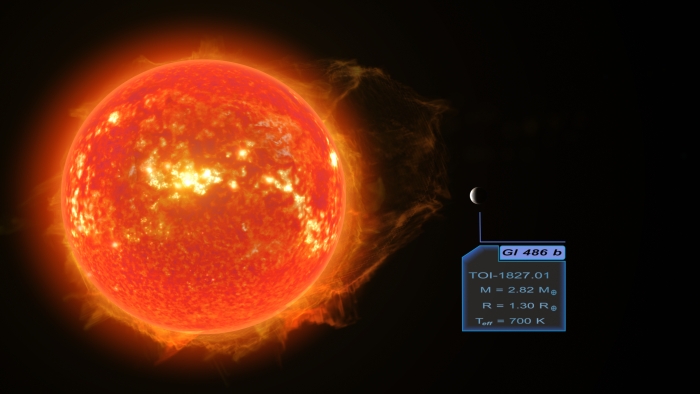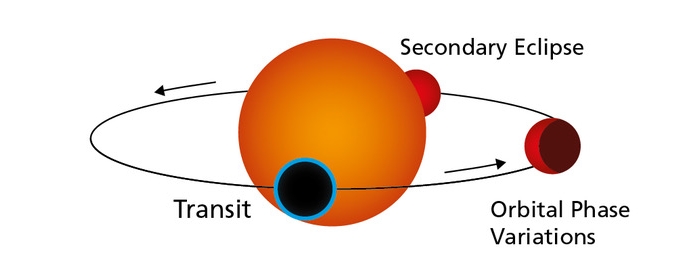An exoplanet just 26 light-years away looks like the one of the best we've found yet for peering into the atmospheres of alien worlds.
Named Gliese 486 b, the exoplanet is a rocky world that astronomers think could be similar to Venus - rocky, hot, and possibly sporting an atmosphere (although it would be a lot thinner than Venus'). And it meets all the criteria that we look for when trying to find exoplanetary atmospheres to probe with the next generation of telescopes.
Not only is it nearby, it passes between us and its star, a relatively cool, calm red dwarf, which will allow its atmosphere to be back-lit. It's also right in the temperature sweet spot for spectroscopy, to analyze the atmospheric composition.
"From the very first moment, we realized that this planet is a jewel: orbiting a nearby bright star and passing in front of it from our viewpoint here on Earth," said astrophysicist Juan Carlos Morales of the Institute for Space Studies of Catalonia.
"We have put our best efforts into precisely determining its properties and are getting ready for further characterization. This planet may become a stepping stone to understand the structure and evolution of exoplanet atmospheres."
 (RenderArea)
(RenderArea)
Since the discovery of the first exoplanet, or planet outside the Solar System, was confirmed in the 1990s, astronomers have gone on to identify thousands of them in the Milky Way galaxy.
What we've discovered so far is an incomplete picture, subject to technological limitations, but even so, we've been able to learn a lot about the different planets out there - their sizes and masses, their densities, how they orbit their stars, that sort of thing.
Atmospheres are a lot more tricky. Generally, we detect exoplanets using two methods based on the effect the exoplanets have on their stars.
There's Doppler spectroscopy: this detects a star's very faint wobbling motion as it moves around in a small circle due to the gravitational interaction with the exoplanet.
And there's transit photometry, which detects the very faint changes in starlight as an exoplanet transits, or moves in front of, the star.
To study an exoplanet's atmosphere, astronomers look for miniscule changes in the wavelength spectrum from a star as an exoplanet moves around it. Some wavelengths will be absorbed or emitted by elements in the atmosphere, showing as darker or brighter lines on the spectrum; these can be used to ascertain the chemical composition of that atmosphere.
As you can imagine, this is quite challenging to do. Exoplanets are very far away, and the signals we're talking about are very faint.
Ideally, to be able to study an atmosphere, you need a few key things. The closer the better; that's one. A bright star whose light should return a strong spectrum is another. And, of course, there's the transiting exoplanet itself, ideally on a short orbit so multiple transits can be observed in a short time and then stacked to amplify the signal.
Exoplanet orbits can be any which way, and if the orbit is short, the exoplanet is very close to the star, which can make it way too hot for spectroscopic observations.
Gliese 486 b, measured to a high precision using both Doppler spectroscopy and transit photometry, has been found to tick all of these boxes.
 (MPIA graphics department)
(MPIA graphics department)
"The proximity of Gliese 486 b allowed us to measure its mass with unprecedented precision, thanks to observations done with the CARMENES and the MAROON-X instruments," astronomer Trifon Trifonov of the Max Planck Institute for Astronomy explained to ScienceAlert.
"Additionally, the planet was also found to periodically cross the stellar disk by NASA's Transiting Exoplanet Survey Satellite (TESS) spacecraft, which is a rare event. Combining a well-characterized planetary mass and orbital configuration from Doppler data, and precise planetary radius and orbital period from transits for such a close exoplanet are what make it an exceptional discovery."
The exoplanet, the research team determined, is around 1.3 times the size of Earth, and around 2.8 times its density. This suggests a terrestrial composition, rich in metals, like Earth or Venus. It also is very close to its star, on an orbit of just 1.5 days.
Because that star is a cool red dwarf, though, the exoplanet's equilibrium temperature is only 700 Kelvin. That might sound tremendously inhospitable to us, but it's just right for atmospheric observations.
"The proximity to the red dwarf Gliese 486 heats the planet significantly to about 430 degrees Celsius (806 degrees Fahrenheit or 700 Kelvin), making its landscape hot and dry, interspersed with volcanoes and glowing lava rivers. In this context, Gliese 486 b is more similar to Venus than to Earth," Trifonov explained.
This is what makes it suitable for emission spectroscopy - when the exoplanet is next to the star, reflecting its light - and studies that involve changes in starlight to search for an atmosphere.
"If the temperature was a hundred degrees colder, it would have been unsuitable for follow-up observations, whereas if it was a hundred degrees hotter, the planet's entire surface would be lava, thus its atmosphere would consist mostly of vaporized rocks, which will tell us nothing about the primordial atmosphere," Trifonov noted.
In every way that is suitable for understanding the atmosphere of an exoplanet, Gliese 486 b is right in the sweet spot. And what if no atmosphere is discovered? Well, that will help us understand how well rocky exoplanets retain their atmospheres when orbiting really close to their stars.
The James Webb Space Telescope, whose mission includes the study of exoplanetary atmospheres, will be launching later this year. Hopefully, Gliese 486 b will be on the menu.
The research has been published in Science.
